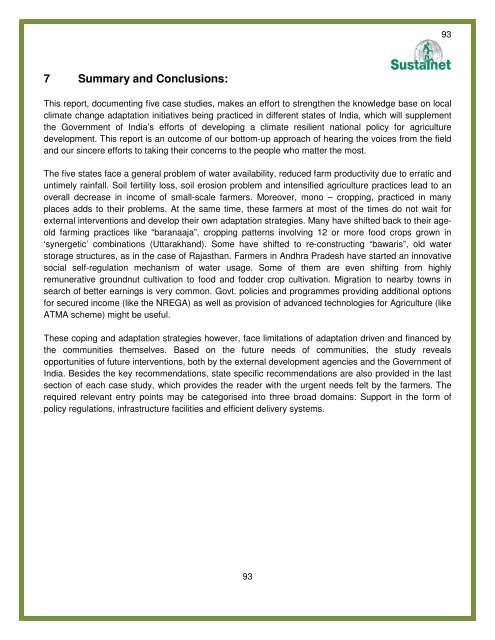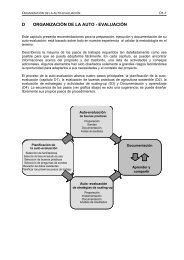Adaptation of small scale farmers to climatic risks in India - Sustainet
Adaptation of small scale farmers to climatic risks in India - Sustainet
Adaptation of small scale farmers to climatic risks in India - Sustainet
You also want an ePaper? Increase the reach of your titles
YUMPU automatically turns print PDFs into web optimized ePapers that Google loves.
7 Summary and Conclusions:<br />
This report, document<strong>in</strong>g five case studies, makes an effort <strong>to</strong> strengthen the knowledge base on local<br />
climate change adaptation <strong>in</strong>itiatives be<strong>in</strong>g practiced <strong>in</strong> different states <strong>of</strong> <strong>India</strong>, which will supplement<br />
the Government <strong>of</strong> <strong>India</strong>’s efforts <strong>of</strong> develop<strong>in</strong>g a climate resilient national policy for agriculture<br />
development. This report is an outcome <strong>of</strong> our bot<strong>to</strong>m-up approach <strong>of</strong> hear<strong>in</strong>g the voices from the field<br />
and our s<strong>in</strong>cere efforts <strong>to</strong> tak<strong>in</strong>g their concerns <strong>to</strong> the people who matter the most.<br />
The five states face a general problem <strong>of</strong> water availability, reduced farm productivity due <strong>to</strong> erratic and<br />
untimely ra<strong>in</strong>fall. Soil fertility loss, soil erosion problem and <strong>in</strong>tensified agriculture practices lead <strong>to</strong> an<br />
overall decrease <strong>in</strong> <strong>in</strong>come <strong>of</strong> <strong>small</strong>-<strong>scale</strong> <strong>farmers</strong>. Moreover, mono – cropp<strong>in</strong>g, practiced <strong>in</strong> many<br />
places adds <strong>to</strong> their problems. At the same time, these <strong>farmers</strong> at most <strong>of</strong> the times do not wait for<br />
external <strong>in</strong>terventions and develop their own adaptation strategies. Many have shifted back <strong>to</strong> their ageold<br />
farm<strong>in</strong>g practices like “baranaaja”, cropp<strong>in</strong>g patterns <strong>in</strong>volv<strong>in</strong>g 12 or more food crops grown <strong>in</strong><br />
‘synergetic’ comb<strong>in</strong>ations (Uttarakhand). Some have shifted <strong>to</strong> re-construct<strong>in</strong>g “bawaris”, old water<br />
s<strong>to</strong>rage structures, as <strong>in</strong> the case <strong>of</strong> Rajasthan. Farmers <strong>in</strong> Andhra Pradesh have started an <strong>in</strong>novative<br />
social self-regulation mechanism <strong>of</strong> water usage. Some <strong>of</strong> them are even shift<strong>in</strong>g from highly<br />
remunerative groundnut cultivation <strong>to</strong> food and fodder crop cultivation. Migration <strong>to</strong> nearby <strong>to</strong>wns <strong>in</strong><br />
search <strong>of</strong> better earn<strong>in</strong>gs is very common. Govt. policies and programmes provid<strong>in</strong>g additional options<br />
for secured <strong>in</strong>come (like the NREGA) as well as provision <strong>of</strong> advanced technologies for Agriculture (like<br />
ATMA scheme) might be useful.<br />
These cop<strong>in</strong>g and adaptation strategies however, face limitations <strong>of</strong> adaptation driven and f<strong>in</strong>anced by<br />
the communities themselves. Based on the future needs <strong>of</strong> communities, the study reveals<br />
opportunities <strong>of</strong> future <strong>in</strong>terventions, both by the external development agencies and the Government <strong>of</strong><br />
<strong>India</strong>. Besides the key recommendations, state specific recommendations are also provided <strong>in</strong> the last<br />
section <strong>of</strong> each case study, which provides the reader with the urgent needs felt by the <strong>farmers</strong>. The<br />
required relevant entry po<strong>in</strong>ts may be categorised <strong>in</strong><strong>to</strong> three broad doma<strong>in</strong>s: Support <strong>in</strong> the form <strong>of</strong><br />
policy regulations, <strong>in</strong>frastructure facilities and efficient delivery systems.<br />
93<br />
93




